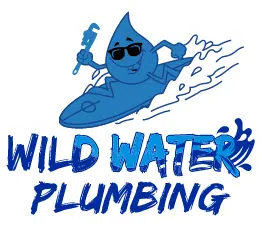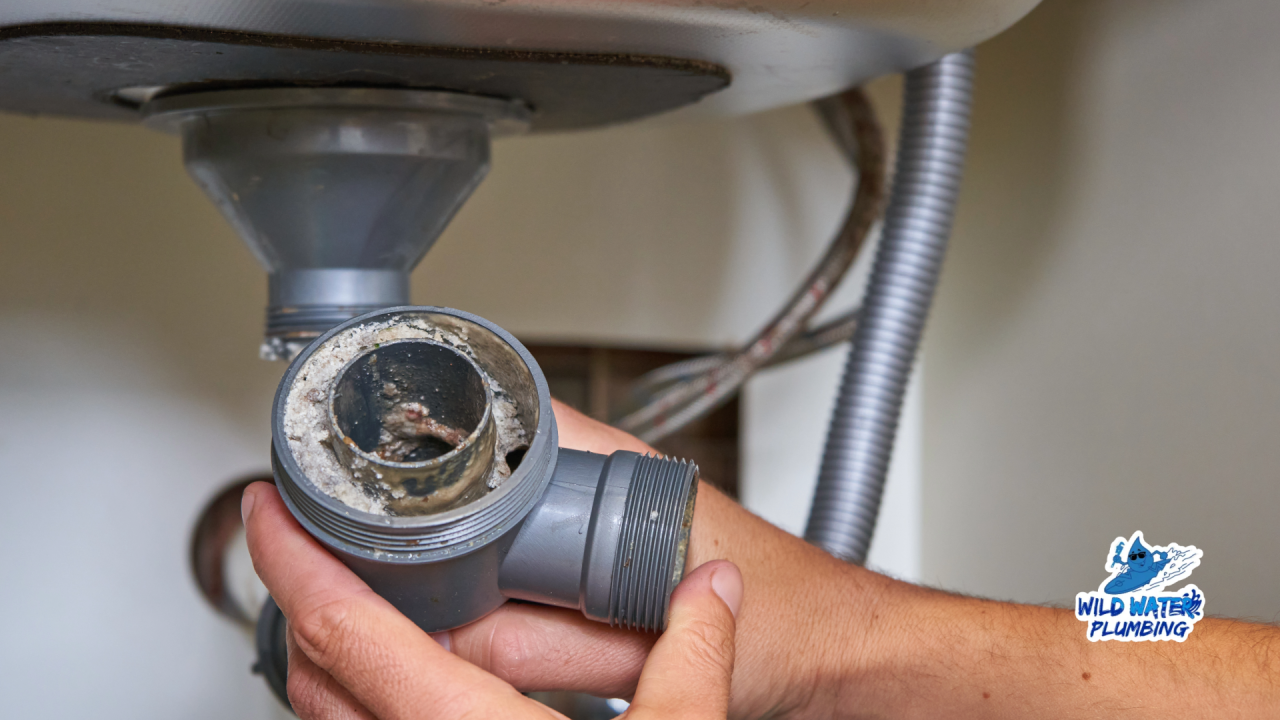Hey, I’m Justin, owner of Wild Water Plumbing in Jacksonville, North Carolina.
I’ve been unclogging drains in Onslow, Pender, Carteret, and New Hanover counties for years.
These coastal counties have their own quirks, so I’ll walk you through why kitchen sinks, showers, toilets – even sump pumps and AC lines – get blocked around here.
I’ll also share what damage clogged drains can do, and how you can dodge the mess.
Coastal Ground, Water Table, and Weather
Our coastal North Carolina soil and weather are pretty unique. We live at low elevations near sea level, so the water table is super high. In fact, the native “Onslow” soil series typically has groundwater just a foot or two below the surface for a few months each year. That means basements or crawlspaces fill up fast, and sewer or septic drain fields have to work with already-saturated ground.
The soil itself is mostly sandy or loamy, which drains quickly on top but shifts easily underneath. When heavy rains hit (remember Hurricane Florence? Parts of Pender County saw around 40 inches of rain from that storm), all that water has to go somewhere. Municipal stormwater can overwhelm the sewer system and literally push sewage back into homes.
Meanwhile the ground shifts underfoot. I’ve seen pipes sag or crack after a big rain. In fact, sandy shifting soil is known to damage underground lines. Even a tiny leak then lets sand in, creating a nasty clog. And septic systems suffer, too: a flooded drain field can’t absorb any more, so the tank pushes sewage back toward the house (ever hear of a backyard sewage geyser? It’s awful).
Coastal storms add storm surges and saltwater, which can infiltrate sewer lines and corrode them. After any big flood, watch your drains carefully. Some homeowners even install one-way backwater valves to protect against that extra flood pressure. It’s worth considering if you’re in a flood zone.
Stuff We Flush or Dump (Don’t!)
Nature isn’t the only culprit – our own plumbing habits cause a ton of clogs.
- Kitchen sinks and disposals: These love to grab grease, coffee grounds, and food scraps. Pour a pot of hot bacon grease down the drain and it cools into a solid plug that catches every crumb and hair that follows. Always wipe pans into the trash instead. If you use a garbage disposal, run cold water and feed tiny bits of food at a time.
- Toilets: Only waste and toilet paper should go down the toilet. Local utilities (like the Cape Fear Public Utility Authority) even post bulletins: no wipes, paper towels, or sanitary products should be flushed. Even “flushable” wipes don’t break down – they just tangle into a rope of hair-and-gunk that blocks the pipe. Remember the rule: pee, poo, and (toilet) paper, and that’s it.
- Showers and bathtubs: Hair and soap scum are the big enemies here. Any hair (or pet fur) that slips past a cheap screen will mix with soap scum on the pipe walls and form a sticky paste over time. A quality drain strainer is cheap insurance. I’ve pulled out some disgusting clogs that were literally a mat of hair and soap!
- HVAC and dehumidifier drains: Your air conditioner or dehumidifier produces a constant drip of water that goes down a small PVC drain line. Over time that line can grow algae or mold (“slime”) that clogs it. When it clogs, water backs up into the pan and overflows (sometimes in the middle of the night!). Clogged AC drain lines can even cause ceiling or floor damage and rampant indoor mold growth. To avoid that, I tell people to pour a cup of white vinegar into the AC condensate drain every 1–3 months. The vinegar kills the slime before it forms. It’s an easy DIY habit that saves a lot of mess.
- Sump pumps: Many homes here have a sump pit to combat the high water table. But that pit only works if it’s kept clean. I’ve opened tons of basements where the sump pit was full of gravel, leaves, or mud – usually because it had no sealed cover. When junk clogs the float or pump, the pump stops working. Also check the discharge line outside; it can get blocked by leaves or even freeze in a sudden cold snap (though that’s rare in NC). Bottom line: clear out the pump pit once a year, test it with a bucket of water, and consider a battery backup. Power outages happen when storms roll in, and a flooded crawlspace during a blackout is a nightmare.
- Garage and floor drains: If you have a floor drain in the garage or laundry, keep it clear of leaves, gravel, or spilled oil. And be absolutely sure it isn’t tied into the sanitary sewer. (Connecting a sump or gutter drain to the sewer is illegal in most towns.) Why? Because that dumps stormwater into pipes meant for sanitary waste only, which quickly overwhelms the system. Overloaded sewers lead to backups not just in your home, but in your neighbors’ homes and streets.
- Tree roots: I keep coming back to this one because it’s huge here. Live oaks, sweet gums, even pine trees have roots that stretch and seek moisture. If they sense a small leak in your sewer line, they’ll grow right into it and branch out. A root-filled sewer is nearly impossible to snake. One tip: if a corner of your yard is inexplicably super-green or soggy, your sewer pipe might be leaking there. Getting a camera down the line to check for roots is a smart move.
- Old or damaged pipes: Many homes in our area were built 40. Clay joints separate and Orangeburg (that compressed tar-paper pipe) literally falls apart after decades. When those pipes crack or collapse, dirt and roots pour in and block the line. If your home is older and no one’s ever scoped the line, consider it overdue.
What Clogged Drains Can Do to Your Home and Health
Let’s get real about why you should care: a sewer backup is nasty and dangerous. Raw sewage contains bacteria, viruses and parasites that can make your family sick (gastroenteritis, hepatitis, eye/ear infections, you name it). Even breathing the sewer fumes or wading in contaminated water isn’t safe. City utilities warn that flushing improper items can cause “sewer main breaks and overflows” – basically, a toxic brew in your house.
Then there’s the damage. Sewage water spreads fast and soaks into everything. Carpets, furniture, clothes, drywall, wood framing – all of it can become contaminated and may need to be ripped out. Moisture from sewage will grow mold within 24–48 hours. Mold spores cause breathing problems and allergies, so a small backup can turn into a huge mold-remediation nightmare.
Overflowing sewage can also undermine your foundation. Most houses here have slab or crawlspace foundations, and if a sewer line is leaking under the slab, it can wash the soil right out from underneath. I had one case in Wilmington where a sewer leak under the garage floor had softened the soil and cracked the concrete – not an earthquake, just sewer water eroding the bas. Foundation repairs are brutal expensive.
In short: don’t think of a little clog as no big deal. Sewage can ruin your stuff, rots your house, and makes you sick. It’s way cheaper and safer to prevent a backup than to clean one up.
Prevention: How Homeowners Can Avoid (or Catch) Clogs
Here’s the real talk: most clogs are preventable or catchable early. A little effort now can save a ton later.
- Watch what you flush/pour. Keep a trash can by the toilet for wipes and personal items. Use grease traps or cans in the kitchen. Only flush the three P’s: pee, poo, and toilet pape.
- Use strainers and screens. Cheap mesh screens on shower and sink drains catch hair and food scraps. Clear them every week. They keep a lot of gunk out of your pipes before it even starts.
- Clean HVAC/drain lines. Flush a cup of vinegar down the AC or dehumidifier drain every month. The vinegar kills algae and mold before it blocks the pipe. Also check that the drain pan isn’t plugged. This small step prevents nasty water leaks and mildew (a clogged AC drain line can cause water damage and mold growth).
- Maintain your sump pump. Test it with water every few months. Keep the pit clear, replace any broken check valve, and clean off the pump screen. Make sure the discharge outlet outside is clear of mulch or leaves. If storms knock out power, a battery backup sump pump (or an alarm that alerts you) can prevent a flood. An electric pump that fails in a storm is how basements flood.
- Listen for warning signs. If a toilet flushes slowly, a shower gurgles, or water bubbles up in one fixture when another is running, call a plumber. Those are classic alarm bells for a partial main-line clog. Often a small partial clog means it’s time to snake the line before it turns into a full backup. I’ve seen drains give a little cough long before disaster – being proactive pays.
- Get a sewer camera inspection. Every few years, have a pro snake a camera through your main sewer line. It’s like a check-up for your pipes. You can literally watch and see tree roots, cracks, sags, or grease traps inside the pipe before they fail. Patching a small crack or cutting roots now is way cheaper than breaking your concrete and digging up a collapsed pipe later.
- Install backflow prevention. If your home is in a low spot or flood-prone, ask about a one-way backwater valve on your sewer line. It lets sewage out but not back in. Many of my customers who had one avoided a second disaster when the storm hit. Also, NEVER tie your downspouts, sump pump or footing drains into the sanitary sewer – it floods the system. Keep stormwater on its own pipes or discharging to grade.
- Protect your trees. If you have big trees near your sewer line, consider root barrier measures or periodically treating with a sewer-safe root-killer. It’s not fun to replace a line under a hundred-year-old oak.
I know plumbing isn’t glamorous, but I promise: the small things make a big difference. Catch a slow drain now, and you avoid a headache later.
Final Thoughts
Living by the ocean and rivers is awesome – until those waters start messing with your plumbing. Our high water table, loose sandy soil, and big storms make sewer clogs way more likely than inland. But with good habits, you can avoid most of the trouble.
I’ve seen drains slow down in Jacksonville, Wilmington, Hampstead and beyond, and almost always it was something manageable (grease buildup, a little root, that forgotten toy in the drain).
Just remember: prevention is key.
Use strainers, flush smart, keep sump pits clean, and call a plumber at the first sign of trouble.
A little vigilance saves a lot of misery – and a lot of money. If you ever smell something funky, notice slow drainage, or just want a pro check your system, give us a contact at Wild Water Plumbing.
We’ll wrangle that wild drain back under control!
Stay safe and dry out there!

